Charles Olsen's Blog: Pensamientos lentos, page 4
November 25, 2020
Ice on the Water in Lyrical Visions V

Ice on the Water, an animation I made with music by Mykl O'Dempsey, will receive its first outing at the festival Lyrical Visions V in Titirangi, New Zealand. It's exciting that it will be in a cinema in these times when most festivals are only online. It will be shown alongside poetry films, animations and music in what looks like a wonderful festival combining international and local creators. You can read the story of how Ice on the Water was made at the start of the pandemic and including connections between the UK, Spain and New Zealand here.

From Liberated words:
Lyrical Visions is an annual celebration of poetry film, animation and music. It’s the brainchild of film makers Martin Sercombe and Robin Kewell. Robin screens the very best of ‘art house’ cinema from Lopdell House in the bush clad Auckland suburb of Titirangi. Martin moved to Titirangi from Norwich, UK in 2014 and teaches film and animation at AUT Auckland and in community settings.
The idea was to bring together Martin and Robin’s work with other local film makers, poets and students, in a format that includes some of the best international cinematic poetry. Each show combines live performances with video projections and single screen works. The fifth year’s programme will include a band of local musicians improvising live to projected films.
The events are sponsored by local businesses and SAE Institute, the school of audio, music and screen production based in Auckland.
For more information about the festival and Martin’s film work, please visit martinsercombe.com
For more about the cinema screenings, see: flickscinema.weebly.com
July 20, 2020
Webster. Feat. Charles Olsen
Webster Collective’s new single ‘Urban Landscape / Paisaje Urbano’ featuring New Zealand poet Charles Olsen will be released on Friday 24 July on all major online platforms.
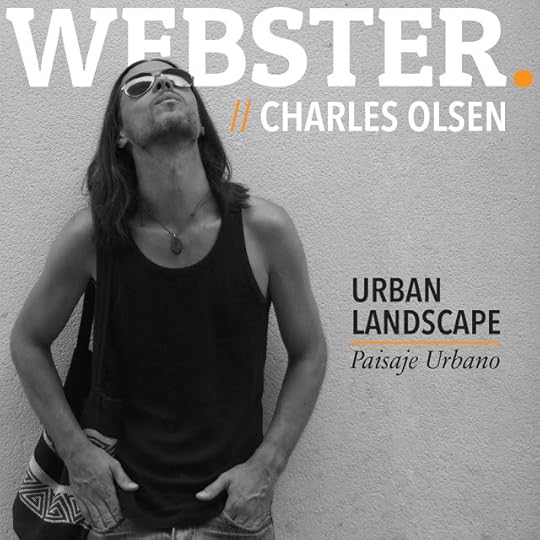
URBAN LANDSCAPE / PAISAJE URBANO
The music began life in 2004, written by Ben Webster Williams and Paul Higgins but it wasn’t until the end of winter 2011 that they invited Charles Olsen to record a spoken word piece for it. He chose the first poem he’d written directly in Spanish ‘Paisaje Urbano’, which tells of lost love set in the neighbourhood of Madrid where he lives. Again there was a long hiatus until 2019 when Ben recorded Andrew Marvell’s drum part on his narrowboat on Hackney Marshes and Charles recorded his neighbour in Madrid, Camilo Bosso (from the group O Sister!) on double bass. Things were beginning to gel and then in March Ben drove up to London to mix the final track with Alex McGowan at Space Eko East, finishing it the day before lockdown.
We can't wait to share it with you. It feels like Summer. So, it comes out 24th July 2020...
Listen to previews on @webstercollective or @colsenart
WEBSTER COLLECTIVE is a shapeshifting, genre-bending music project coordinated by Ben Webster Williams and largely brewed in the UK, with ingredients often sourced worldwide. A melting pot of creatives, the Webster Collective takes its time, letting tracks develop at their own pace and bringing together diverse vocalists, poets, musicians and producers for special collaborations.
July 18, 2020
Noho Mai
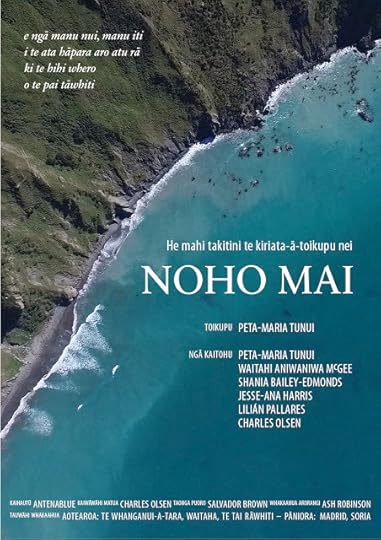
NOHO MAI is a collaborative te reo Māori poetry film created during an online writing and film workshop run by Charles Olsen and Peta-Maria Tunui during the Covid-19 confinement in Spain and Aotearoa, New Zealand, March - July 2020. It has been selected for the Wairoa Māori Film Festival in October 2020.
'Symbolized in the bird’s flight, a group of Māori, Pākehā and Colombian creatives explore life’s journey, the longing to return to the nest, and the life-giving connection with our ancestors.'
Watch the trailer here:
April 17, 2020
Ice on the Water
[Saltar al español]
Travelling the world despite the lockdown. Charles Olsen shares his latest poetry film collaboration, Ice on the Water, and tells the journey of its creation that joins dots between the UK, Spain and New Zealand.
Back in England in the late-1990s my kiwi friend, singer Celine Filbee, introduced me to some musician friends of hers. I took my new MiniDisc recorder along to one of their get-togethers and recorded Mykl O’Dempsey singing his composition ‘Ice on the Water’. It is a short enigmatic song set to a beautiful lilting guitar and I immediately fell in love with it.
Forward twenty-something years… and Mykl has moved to the other end of the globe, to Lyttleton, which he comments ‘has a great many creative artists in the community.’ He is working as a Counsellor/Therapist/Social worker, which has taken him many places including a spell working in the Maldives and more recently to work in prisons. He continues writing and occasionally performs.
I am now living at the antipodes in Madrid, Spain, where I currently have an Artists Residency together with writer and actress, Lilián Pallares, at Matadero Madrid, as well as painting, writing and making poetry films. I had always wanted to do something with Mykl’s song and needed some diversion during the continuing lockdown in Madrid so I began sketching out a character and created a cut-out articulated figure, his joints held by knotted cotton, and began telling his story.
Although I had listened to the song many times and copied out the lyrics, the meaning of the song was illusive. I like what Mykl has since told me about the song:
‘I can’t say I remember when I wrote it. Some songs take a lot of work with multiple writings and edits, other songs have a kind of whakapapa in which I can see their origins in earlier songs, either mine or by others. Sometimes, very rarely, a song just manifests and arrives complete. Ice on the Water arrived like that.
‘Lyrically it is structured like an evocation. Short lines each containing a single image/idea, fragmented but linked to the others. And as I think about it now I see similarities to the way prayers are structured. Like “Our Father/Who art in heaven/Hallowed be thy name” etc. Or "Hail Mary/Full of grace.”
‘I am dyslexic, or at least I was as a child, and there are times as an adult that reading and writing (particularly spelling) becomes very much harder. Consequently I tend to write out loud rather than writing to screen or paper.
‘I usually write without trying to tie my lyrics together with logical or definite meaning. The lyrics often explore an ambiguity that I am feeling, and in leaving the meanings unresolved I hope I invite the listener to explore and generate their own meaning or explore an ambiguity of their own.
'The only characters are I and “no-one”. For me there is a kind of frozen outsider disconnection and aloneness about the piece.'
‘Most of my writings have some sort of narrative within them. There are often people (you, I, he, she) who are involved in some kind of drama or relationship. Ice on the Water is different. The only characters are I and “no-one”. For me there is a kind of frozen outsider disconnection and aloneness about the piece. It is a kind of feeling that I think I have seen evoked in films by Ingmar Bergman or Tarkovsky (Solaris, 1972), or at least what those films have come to encapsulate in my memory. They may in reality be nothing like I recall them.’
Through the process of animating my character I found my own personal interpretation of Mykl’s song, a particular melancholy of a solitary but apparently happy man who loves—or dreams of—ice-skating, but is unable to connect with his deeper self. When he gets his gumboots on I’m taken back to reading the Footrot Flats books at my grandparents in Takapau.
I had not asked Mykl if I could use the recording so he had no idea what I was doing. He had probably forgotten I had even recorded the song, it was so long ago! I wanted the whole thing to be a surprise. So I was a little nervous as to his reaction when I pressed send on Messenger:
—Hi Mykl, Hope you and the family are all well. I have a something I've been working on the last few days that I want you to be the first to see... https://vimeo.com/407177452 I hope you like it!
It was late at night in Spain so daytime in New Zealand and he responded shortly after:
—Hi Charles I have often thought of you especially in recent weeks. We are well thanks. Wishing you and yours good health and resilience. Vimeo says I need a password to open the file.
—ahhh... the password is mykl
And a few minutes later:
—I’m speechless and feel so honoured. Thank you.

We quickly decided we wanted to share it with the world along with the story of its making. I asked Mykl for his memories of writing the song and he also shared his thoughts on my interpretation:
‘There is something about the style you have used that mirrors some of the single image/idea in the structure of the lyrics. A kind of “Now this is happening… Now this is happening”, perhaps it is more “Now this…. Now this”.
‘I was reminded of a character from a very old British children's TV series called Noggin the Nog, created by Oliver Postgate. Noggin the Nog was probably one of the first pieces of television I would have seen. So I looked on YouTube and discovered that they are not similar in the way the images are constructed. Now I recognise that your images have done for me what I hope my lyrics will do for others i.e. reflect and explore ones own inner connections. I suppose this is a parallel to my recollections of the directors described earlier.’
I am lucky I can continue creating new projects and we can find alternative ways to connect and reconnect with people and friends
For me this forced lockdown here in Spain—only allowed out to get food and medicines, or travel to work if your job is counted as essential—has been a time to step back and reflect. It looks very likely the restrictions in Spain will remain in place at least until early May but I am lucky I can continue creating new projects and we can find alternative ways to connect and reconnect with people and friends in a time of social distancing the world around.
The philosopher and poet John O’Donohue wrote, in his wonderfully thought-provoking Eternal Echoes—Exploring our hunger to belong, of the conformity and order of our daily lives and the society we live in, while ‘almost unknown to ourselves, we are standing on a wild earth at a crossroads in time where anything can come towards us. Yet we behave as if we carried the world and were the executives of a great plan. Yet everywhere around us mystery never sleeps. The same deep nature is within us. Each person is an incredibly sophisticated, subtle and open-ended work of art. We live at the heart of our own intimacy, yet we are strangers to its endless nature.’ It is this ambiguity of the person caught between daily life and their inner wildness I wanted to capture and the also song recognises something of this in the line: ‘I must have been diving so long.’
I hope you enjoy our collaboration: a two-minute-long song recorded in the 1990s, three days of animating in April 2020 and a surprise beamed to the other side of the world!
Mykl O’Dempsey grew up in the UK. He has written since the late 1970s and has been a member of several bands including the heavily psychedelic and extremely loud Magic Mushroom Band, and the more reflective and meditative instrumental group Tuu. He migrated to New Zealand a little over 20 years ago, now living in Lyttelton where he is kept busy by his two teenage sons. He works as a Counsellor/Therapist/Social worker and continues to write and occasionally performs.
Charles Olsen is from Nelson, New Zealand. He moved to Spain drawn by his interest in Spanish artists such as Velázquez and Goya and to study flamenco guitar. Artist, filmmaker and poet, his paintings have been exhibited in the UK, France, New Zealand and Spain, and he has two bilingual collections of poetry published in Spain, Sr Citizen (Amargord, 2011) and Antípodas (Huerga & Fierro, 2016). His short film The dance of the brushes was awarded second prize in the I Flamenco Short Film Festival in Spain and his poetry films have been shown at international festivals and featured online in Moving Poems, Poetry Film Live and Atticus Review. In 2018 he was awarded the III Antonio Machado Poetry Residency in Segovia and Soria and he has received the XIII distinction Poetas de Otros Mundos. In 2020 he has received a year-long Artists Residency together with Colombian writer and actress, Lilián Pallares, at Matadero Madrid.
Hielo Sobre el Agua
En inglés con subtítulos en español (pinchar en CC).
Viajando por el mundo a pesar del encierro. Charles Olsen comparte su última colaboración de videopoesía, Hielo Sobre el Agua, y cuenta el viaje creativo que conecta el Reino Unido, España y Nueva Zelanda.
En Inglaterra a finales de la década de 1990 mi amiga, la cantante Celine Filbee, me presentó a algunos amigos músicos suyos. Llevé mi nueva grabadora MiniDisc a una de sus reuniones y grabé Mykl O’Dempsey cantando su composición Hielo Sobre el Agua. Es una canción enigmática con una guitarra hermosa, cadenciosa, e inmediatamente me enamoré de ella.
Pasaron veintitantos años ... y Mykl se ha mudado al otro extremo del mundo, a Lyttleton en la Isla Sur de Nueva Zelanda, que dice él «tiene una gran cantidad de artistas creativos en la comunidad». Se desempeña como consejero/terapeuta/trabajador social, trabajos que le han llevado a muchos lugares, incluso a vivir una temporada en las Maldivas, y más recientemente a trabajar en cárceles. Sigue escribiendo y ocasionalmente actúa.
Ahora yo vivo en las antípodas, Madrid, donde actualmente tengo una residencia artística junto a la escritora y actriz, Lilián Pallares, en Matadero Madrid, además de pintar, escribir y realizar videopoemas con mi productora antenablue. Siempre quise hacer algo con la canción de Mykl y necesitaba un poco de diversión durante el encierro, así que comencé a dibujar un personaje y creé una figura articulada recortada, sus extremidades sostenidas por algodón anudado, y comencé a contar su historia.
Aunque había escuchado la canción muchas veces y copiado la letra, el significado era inasible. Me gusta lo que Mykl me ha contado sobre cómo nació:
«No puedo decir que recuerdo cuando la escribí. Algunas canciones requieren múltiples revisiones, otras tienen una especie de genealogía en la que puedo ver sus orígenes en temas anteriores, ya sean míos o de otros. A veces, muy raramente, una canción simplemente se manifiesta y llega completa. Hielo Sobre el Agua llegó así.
«Líricamente está estructurada como una evocación. Líneas cortas, cada una de las cuales contiene una sola imagen/idea, fragmentada pero vinculada a las demás. Y al pensarlo ahora veo similitudes con la forma en que se estructuran las oraciones como: "Padre nuestro/que estás en el cielo/santificado sea tu nombre", etc., o "Dios te salve María/llena eres de gracia".
«Soy disléxico, o al menos lo fui cuando era niño, y hay veces que, como adulto, leer y escribir (especialmente la ortografía) se vuelve mucho más difícil. En consecuencia, tiendo a escribir en voz alta en lugar de escribir en la pantalla o en el papel.
«Normalmente escribo sin tratar de vincular mis letras con un significado lógico o definido. Las letras a menudo exploran una ambigüedad que estoy sintiendo, y al dejar los significados sin resolver, espero invitar al oyente a explorar y generar su propio significado o explorar una ambigüedad propia.
«Los únicos personajes son yo y "nadie". Para mí, hay una especie de desconexión y soledad ajena congelada sobre la pieza».
«La mayoría de mis escritos tienen algún tipo de narrativa dentro. A menudo hay personas (usted, yo, él, ella) que están involucradas en algún tipo de drama o relación. Hielo Sobre el Agua es diferente. Los únicos personajes son yo y "nadie". Para mí, hay una especie de desconexión y congelada soledad ajena en la pieza. Es un sentimiento que creo haber visto evocado en películas de Ingmar Bergman o Tarkovsky (Solaris, 1972), o al menos lo que esas películas han encapsulado en mi memoria. Puede que en realidad no sean como yo las recuerdo».
A través del proceso de animar al personaje, encontré mi propia interpretación personal de la canción de Mykl, una melancolía particular de un hombre solitario pero aparentemente feliz que ama, o sueña con, patinar sobre hielo, pero no puede conectarse con su yo más profundo. Cuando se pone las botas de goma, vuelvo a los libros de Footrot Flats que tenían mis abuelos en Takapau.
No le había preguntado a Mykl si podía usar la grabación. Él no tenía ni idea de lo que estaba haciendo. Probablemente había olvidado incluso de que había grabado la canción, ¡fue hace tanto tiempo! Quería que todo fuera una sorpresa. Así que estaba un poco nervioso por su reacción cuando presioné enviar en el Messenger:
—Hola Mykl, espero que tú y tu familia estén bien. Tengo algo en lo que he estado trabajando durante los últimos días y quiero que seas el primero en verlo... https://vimeo.com/407177452 ¡Espero que te guste!
Era de noche en España y de día en Nueva Zelanda. Él respondió enseguida:
—Hola Charles, muchas veces he pensado en ti, especialmente en las últimas semanas. Estamos bien gracias. Deseándote a ti y a los tuyos buena salud y resistencia. Vimeo dice que necesito una contraseña para abrir el archivo.
—Ahhh... la contraseña es mykl
Y unos minutos después:
—Estoy sin palabras y me siento muy honrado. Gracias.

Decidimos que queríamos compartirlo con el mundo junto con la historia de su creación. Le pregunté a Mykl por sus recuerdos al escribir la canción y también compartió sus pensamientos sobre mi interpretación:
«Hay algo en el estilo que has utilizado que refleja parte de la imagen/idea única en la estructura de la letra. Una especie de "Ahora esto está sucediendo… Ahora esto está sucediendo", tal vez sea más "Ahora esto ... Ahora esto".
«Me acordé de un personaje de una serie de televisión infantil británica muy antigua llamada Noggin the Nog, creado por Oliver Postgate. Noggin the Nog fue probablemente una de las primeras piezas de televisión que ví. Así que busqué en YouTube y descubrí que no es similar la forma en que se construyen las imágenes. Ahora reconozco que sus imágenes han hecho por mí lo que espero que mis letras hagan por los demás, es decir, reflejar y explorar las propias conexiones internas. Supongo que esto es un paralelo a mis recuerdos de los directores descritos anteriormente».
Tengo la suerte de poder continuar creando nuevos proyectos y podemos encontrar formas alternativas de conectar y reconectar con personas y amigos.
Para mí, este encierro forzado aquí en España—solo se les permite salir para obtener alimentos y medicinas, o viajar al trabajo si su trabajo está considerado esencial—ha sido un momento para retroceder y reflexionar. Parece muy probable que las restricciones en España se mantengan vigentes al menos hasta principios de mayo, pero tengo la suerte de poder continuar creando nuevos proyectos y podemos encontrar formas alternativas de conectar y reconectar con personas y amigos en un momento de distanciamiento social del mundo.
El filósofo y poeta John O'Donohue escribió, en su maravillosamente sugerente Eternal Echoes—Exploring our hunger to belong ('Ecos Eternos—Explorando nuestra hambre de pertenecer'), de la conformidad y el orden de nuestra vida cotidiana y la sociedad en la que vivimos, mientras que "casi desconocidos para nosotros mismos, somos parado en una tierra salvaje en una encrucijada en el tiempo donde cualquier cosa puede venir hacia nosotros. Sin embargo, nos comportamos como si transportáramos el mundo y fuéramos los ejecutivos de un gran plan. Sin embargo, en todas partes a nuestro alrededor el misterio nunca duerme. La misma naturaleza profunda está dentro de nosotros. Cada persona es una obra de arte increíblemente sofisticada, sutil y abierta. Vivimos en el corazón de nuestra propia intimidad, pero somos extraños a su naturaleza infinita". Es esta ambigüedad de la persona atrapada entre la vida cotidiana y su locura interior lo que quería capturar, y la canción también reconoce algo de esto en la línea: "Debo haber estado buceando tanto tiempo".
Espero que disfruten de nuestra colaboración: ¡una canción de dos minutos de duración grabada en la década de 1990, tres días de animación en abril de 2020, y una sorpresa transmitida al otro lado del mundo!
Mykl O’Dempsey creció en el Reino Unido. Ha escrito desde fines de la década de 1970 y ha sido miembro de varias bandas, incluida la Magic Mushroom Band, muy psicodélica y extremadamente ruidosa, y el grupo instrumental más reflexivo y meditativo Tuu. Emigró a Nueva Zelanda hace poco más de 20 años, ahora vive en Lyttelton en la Isla Sur, donde sus dos hijos adolescentes lo mantienen ocupado. Trabaja como consejero/terapeuta/trabajador social y sigue escribiendo y de vez en cuando hace actuaciones.
Charles Olsen es de Nelson, Nueva Zelanda. Se mudó a España atraído por su interés en artistas españoles como Velázquez y Goya y para estudiar guitarra flamenca. Artista, cineasta y poeta, sus pinturas han sido expuestas en el Reino Unido, Francia, Nueva Zelanda y España, y tiene dos colecciones de poesía bilingües publicadas en España, Sr Citizen (Amargord, 2011) y Antípodas (Huerga & Fierro, 2016). Su cortometraje La danza de los pinceles recibió el segundo premio en el I Festival de Cortometrajes Flamencos de España y sus películas de poesía se han exhibido en festivales internacionales y se han presentado en línea en Moving Poems, Poetry Film Live y Atticus Review. En 2018 recibió la III Beca de Poesía SxS Antonio Machado y ha recibido la XIII distinción Poetas de Otros Mundos. En 2020 recibió una Residencia Artística de un año junto con la escritora y actriz colombiana, Lilián Pallares, en Matadero Madrid.
March 8, 2020
Being children in ARCO 2020 – Siendo niños en ARCO 2020
Lilián y yo visitamos ARCO 2020, la feria internacional de arte de Madrid, como parte de nuestra residencia en Matadero Madrid. Observamos la feria a través de la mirada de la infancia y el juego, en algunos aspectos la antítesis de un mercado de arte y en otros tal vez más cerca de la intención de los propios artistas.
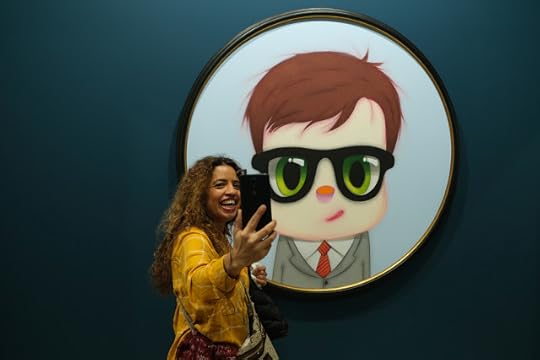
In the midst of our deliberations we received a video-call from Mia, our six year-old niece, and had fun showing her different works we had found, the first failing her interest criteria until we showed her Javier Calleja's large comic-type portraits. A large cute portrait of a bespectacled man in jacket and tie could reference cartoons, an avatar, cute phone filters. Is it a comforting vision of an adult world of work, making business palatable? Or a child-like vision of grown-ups? Mia turned him into a little girl with her hair cut short and playing dress-ups in thick glasses and tie. She loved it but then she also loved a sculpture of a detached woman's head which she and Lilián wove a story around, and some colourful abstract paintings.
En medio de nuestras reflexiones, recibimos una videollamada de Mia, nuestra sobrina de seis años, y nos divertimos mostrándole diferentes trabajos que habíamos encontrado, los primeros no cumplieron con sus criterios de interés hasta que le mostramos los grandes retratos tipo cómic de Javier Calleja. Un retrato grande y lindo de un hombre con gafas con chaqueta y corbata podría hacer referencia a dibujos animados, un avatar, lindos filtros de teléfono. ¿Es una visión reconfortante de un mundo laboral adulto que hace que los negocios sean sabrosos? ¿O una visión infantil de adultos? Mia lo convirtió en una niña con el pelo corto y disfrazada con gafas gruesas y corbata. Le gustó, pero también le encantó una escultura de la cabeza tumbada de una mujer con la que ella y Lilián tejieron una historia, y algunas pinturas abstractas coloridas.
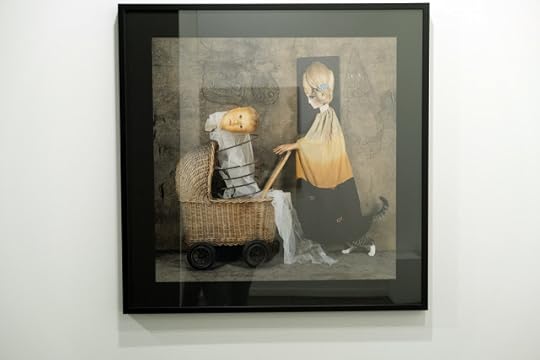
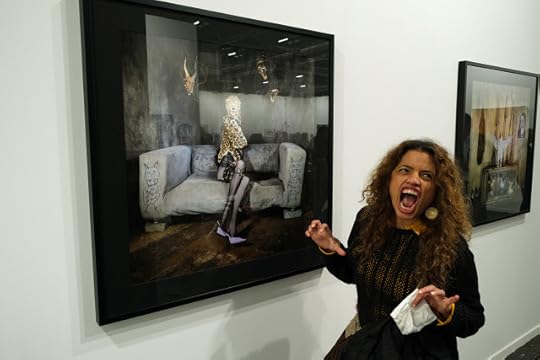
One of the few artists in ARCO to directly draw on childhood was Roger Ballen, whose photographs are filled with references to infancy, often including children in the works. These unsettling scenes are filled with loosely sketched faces on walls and furniture – the child in the artist let loose on the rooms. These are spaces for the imagination to loosen and run off with strange and mysterious narratives, like hearing a story told around a camp fire with your back to the shadows.
Uno de los pocos artistas en ARCO que utilizaba la infancia fue Roger Ballen, cuyas fotografías están llenas de referencias a la infancia, y a menudo incluye niños en sus obras. Estas escenas inquietantes están llenas de rostros sueltos en paredes y muebles: el niño del artista se soltó en las habitaciones. Estos son espacios para que la imaginación se relaje y se escape con narraciones extrañas y misteriosas, como escuchar una historia contada alrededor de una fogata, de espaldas a las sombras.

Lilián's inner child delighted in a humble dwelling beneath a canopy of palm trees that spilled onto the walls in sketchy blue brushstrokes saying 'This reminds me of the drawings I did as a child. I always drew a house like this by the sea surrounded by palm trees and lots of colour. It's my dream house in the land I'm from'. The work is by Adriana Ciudad who is currently working in Bogota, Colombia, and formed part of her 2018 exhibition Salgan ríos de mis ojos (Come rivers out of my eyes).
La niña interior de Lilián se deleitaba frente una humilde vivienda debajo de un dosel de palmeras que se derramaba en las paredes de la galería con pinceladas azules. Decía 'Esto me recuerda los dibujos que hice cuando era niña. Siempre dibujé una casa como esta frente al mar rodeada de palmeras y mucho color. Es la casa de mis sueños en la tierra de donde vengo'. El trabajo es de Adriana Ciudad, que actualmente trabaja en Bogotá, Colombia, y formó parte de su exposición de 2018, Salgan ríos de mis ojos.
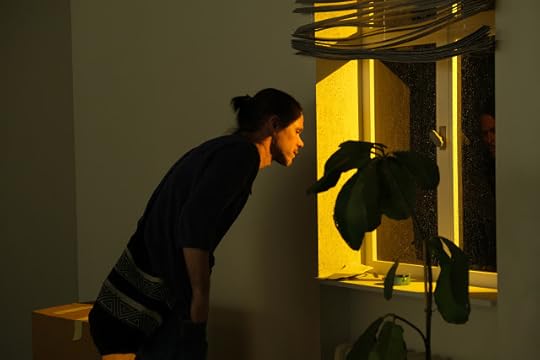
We both loved an installation by Alvaro Urbano titled Hands as drawers – a space for the imagination, sparking memories of moving house, places left behind, unread letters arriving at an old address. Growing up in New Zealand my parents often moved house. Tapawera, Culverden, Dunedin, Wellington… Every three or four years we would pack up house and move for my father's work in the church. My mother once wrote the story of our move with drawings of my sister and me packing boxes as a way of preparing us for the big change.
The full ashtray: the circles of smoke that would have risen in the light from the streetlamp; the fretting person who had reason to leave. Stepping into the light you become like a lone figure in a painting by Edward Hopper. The rain on the window evokes memories of wet days playing indoors, car journeys staring at the droplets play on the window. On close inspection, like looking up close at a painting, I noticed the window knob is not shop-bought but handmade, and it wasn't until I read about the installation later that I found the potplant with its fallen leaves and the taped cardboard boxes are not real but are carefully made from painted metal. The physical nature of the installation, being part of the space, gives the spectator a playful immersive experience with clues – like a detective novel – in a space which at first glance is just an empty room, perhaps even a forgotten corner of the art fair where the gallery owner forgot to turn up and unpack the works.
A los dos nos encantó una instalación de Alvaro Urbano titulada Hands as drawers (Las manos como cajones): un espacio para la imaginación, que genera recuerdos de mudanzas, lugares abandonados, cartas no leídas que llegan a una dirección antigua. De niño creciendo en Nueva Zelanda, mis padres a menudo se mudaban de casa. Tapawera, Culverden, Dunedin, Wellington ... Cada tres o cuatro años empacamos casa y nos mudamos por el trabajo de mi padre en la iglesia. Mi madre una vez escribió la historia de nuestra mudanza con dibujos de mi hermana y yo preparando las cajas, como una forma de prepararnos para el gran cambio.
El cenicero lleno: los círculos de humo que habrían salido a la luz de la farola; la persona inquieta que tenía motivos para irse. Al estar en la luz te conviertes en una figura solitaria en una pintura de Edward Hopper. La lluvia en la ventana evoca recuerdos de días húmedos jugando en el interior, viajes en automóvil mirando a las gotas que corren por el cristal. En una inspección minuciosa, como mirar de cerca una pintura, noté que el pomo de la ventana no se compra en la tienda, sino que está hecho a mano, y no fue hasta que leí sobre la instalación más tarde cuando encontré que la maceta con su planta con hojas caídas y las cajas de cartón con cinta, no son reales, sino están hechas cuidadosamente de metal pintado. La naturaleza física de la instalación, al ser parte del espacio, le brinda al espectador una experiencia lúdica inmersiva con pistas, como una novela negra, en un espacio que a primera vista es solo una sala vacía, tal vez incluso un rincón olvidado de la feria de arte donde la galerísta ha olvidó llegar para desempaquetar las obras.
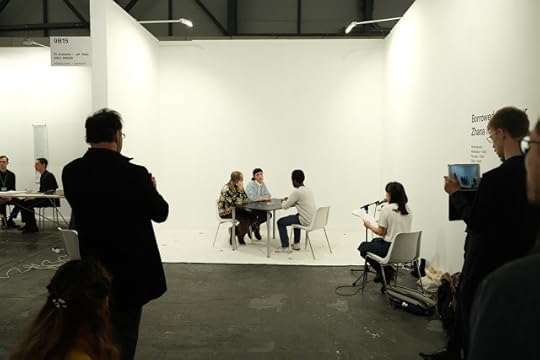
Another 'empty space' was that occupied by the piece Borrowed splendour by Zhana Ivanova. In contrast with the abandoned space of Urbano this contains three people, three chairs and a table. Like in a children's game, from the sidelines two people sit at microphones reading out instructions to the participants. Here the cigarettes are being smoked, as gestures and looks both link and distance the figures. There are funny moments, awkwardness, knowing looks, an undermining of social norms. Do the participants follow the instructions or decide to make up their own game? In the context of an art fair where most galleries have a desk with the owners sit working at laptops or awaiting for visitors, this desk takes on a playful nature where it becomes the focus of attention between empty white walls.
Otro 'espacio vacío' fue el ocupado por la pieza Borrowed splendour (Esplendor prestado) de Zhana Ivanova. En contraste con el espacio abandonado de Urbano, este contiene tres personas, tres sillas y una mesa. Como en un juego de niños, desde los lados, dos personas se sientan frente a micrófonos y leen instrucciones a los participantes. Aquí se fuman los cigarrillos, y los gestos y las miradas vinculan y distancian las figuras. Hay momentos divertidos, torpezas, miradas de conocimiento, un debilitamiento de las normas sociales. ¿Los participantes siguen las instrucciones o decidiran a inventar su propio juego? En el contexto de una feria de arte donde la mayoría de las galerías tienen un escritorio con los propietarios sentados trabajando en portátiles o esperando a los visitantes, esta mesa adquiere una naturaleza lúdica donde se convierte en el foco de atención entre paredes blancas vacías.
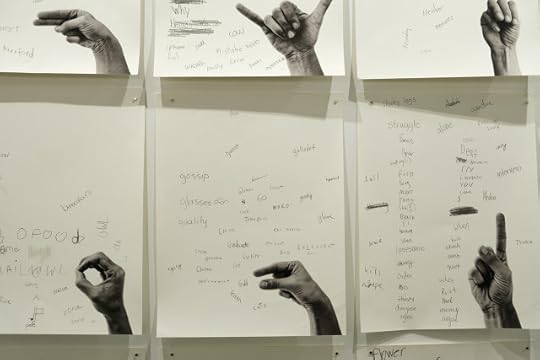
And finally, we found some poetry in ARCO! In Estudios de rimas por formas de la mano (Studies in rhymes in the shapes of the hand) by Francisca Benítez, photographs of 37 signs from American Sign Language (ASL) have been annotated by students during a poetry workshop. Signs can visually rhyme with each gesture representing different words depending on, among other things, the position, movement of the hand, or its combination with different facial expressions. Through the images we share in the exploration of the excitement of creating a new world of expression through ASL.
Lilián and I love creating poetry films and plan among other things to make new pieces during our residency. The above piece was accompanied by the video that follows, Son en Señas: tres poemas (Sign rhymes: three poems), which formed part of a collective performance by Francisca Benítez in collaboration with members of Cuba's National Association for the Deaf in Havana, 2015. The poems are by Nicolás Guillén:
Bomba atómica (Atomic bomb) interpreted by Michel Carballo
Balada de los dos abuelos (The ballad of two grandparents) interpreted by Leonel Prieto and Lisandro Massipe
Caminando (Walking) interpreted by Maité Chaveco
Y finalmente, ¡encontramos algo de poesía en ARCO! En Estudios de rimas por formas de la mano, de Francisca Benítez, los estudiantes anotaron fotografías de 37 signos del lenguaje de señas, American Sign Language (ASL), durante un taller de poesía. Al igual que la palabras, los signos riman visualmente: un mismo gesto puede representar diferentes palabras dependiendo, entre otras cosas, de la posición, el movimiento de la mano o su combinación con diferentes expresiones faciales. A través de las imágenes, compartimos la exploración de la emoción de crear un nuevo mundo de expresión a través de ASL.
Lilián y yo amamos crear videopoemas y planeamos, entre otras cosas, hacer nuevas piezas durante nuestra residencia. La pieza anterior fue acompañada por el video que sigue, Son en Señas: tres poemas, que formó parte de una actuación colectiva de Francisca Benítez en colaboración con miembros de la Asociación Nacional de Sordos de Cuba en La Habana, 2015. Los poemas son de Nicolás Guillén:
Bomba atómica interpretado por Michel Carballo
Balada de los dos abuelos interpretado por Leonel Prieto y Lisandro Massipe
Caminando interpretado por Maité Chaveco
If only we can continue to look at the world with the curiosity of childhood; to play with ideas and be open to new stories, and not just be content to spout, 'I don't understand art but I know what I like'.
Si pudiéramos seguir mirando el mundo con la curiosidad de la infancia; jugar con ideas y estar abierto a nuevas historias, y no solo contentarnos con exponer: "No entiendo el arte, pero sé lo que me gusta".
March 5, 2020
He awheawhe kiriata-ā-toikupu – Poetry Film Workshop
Are you interested in writing poetry in te reo Māori and exploring the relationship between words and film? Writer and performer Peta-Maria Tunui (In*ter*is*land Collective), together with the Spain-based duo, Charles Olsen and Lilián Pallares (antenablue.com), both poets and audiovisual creatives, are preparing a collaborative writing and poetry film workshop in Porirua, Aotearoa – New Zealand.
If you are a writer or filmmaker and are interested in working in this international te reo Māori project please contact for more information:
Charles Olsen hola@antenablue.com whatsapp: +34 654 015 349
or Peta-Maria Tunui petamaria.tunui@gmail.com whatsapp: +44 7504 631 650
February 15, 2020
'Playing in the sun' – the Prado Museum
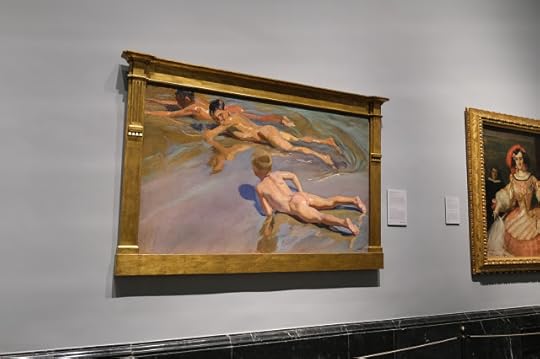
In the Prado there are many representations of the children of wealthy patrons, princes and princesses in ornate clothing, but also pieces such as Boys on the beach (1909) by Joaquín Sorrolla, painted al fresco on the Valencian coast, which captures the freedom and sensuousness of children enjoying the sun, sand and the wash of the waves. When I was their age I would have gone to a beach on the Otago peninsula in the South Island, New Zealand, with a more turbulent sea, very different from the Mediterranean.
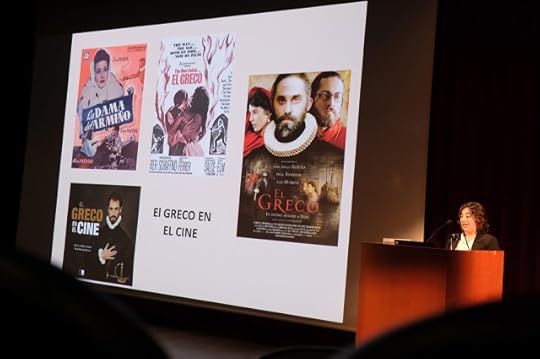
In a series of lectures for teachers the Prado is presenting films about artists represented in the collection with talks on how the film can be used in the classroom. On 15 February we saw the film El Greco, followed by a presentation by María Silvia López Gallegos. It was particularly interesting how the historical inaccuracies in the film are used as a challenge to the students to find the real story. It was great after the lecture to be able to go into the galleries and see the original paintings of El Greco in the Prado.
El Greco (2007), Trailer:
After the lecture I took Lilián to see some of my favourite paintings. One of the reasons I moved to Spain was the work of El Greco, Goya and Velázquez. I particularly love these paintings, The Boy from Vallecas (Francisco Lezcano) and Buffoon with Books by Velázquez.
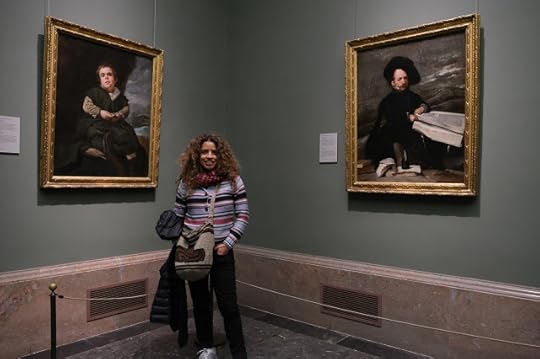
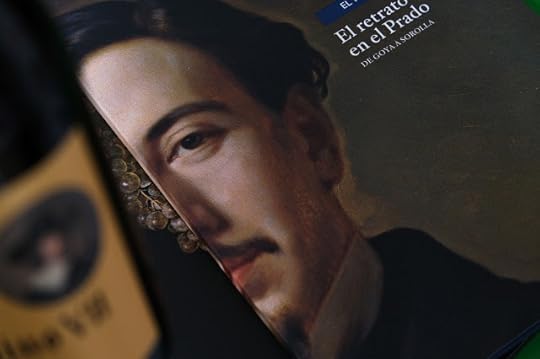
February 12, 2020
Charles Olsen translates Lilián Pallares
You can read them here: https://ojs.victoria.ac.nz/neke/article/view/6313
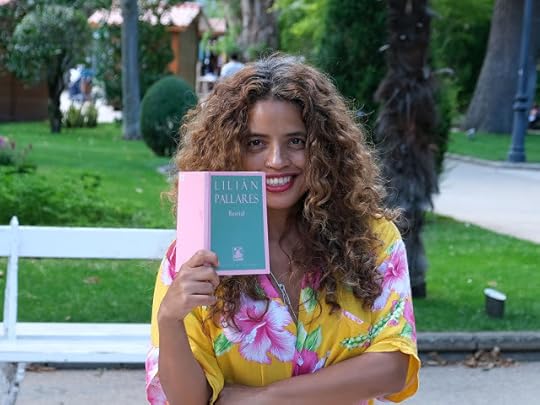 Lilián Pallares during Expoesía Poetry Festival in Soria, 2019. Photo: Charles Olsen.
Lilián Pallares during Expoesía Poetry Festival in Soria, 2019. Photo: Charles Olsen.
February 6, 2020
Painting sound
I had piano lessons from five years old until I was ten, and then I had two years of clarinet. With my mother being a professional singer we always had a piano at home, and even though I didn't continue with classes I still enjoy practising. I remember popping into a music shop in Farnham when I was there doing an Art Foundation course and finding sheet music of Peter Dickinson, Alexandre Tansman and Jonathan Harvey, and the excitement of turning the notes on the page into sound.
My parents had collections of classical repertoire and I was especially drawn to Robert Schumann. One particular piece I learnt off by heart but I don't remember the name of it. I went off to university and took up the guitar as it was more practical than the piano for travelling, and soon got caught up with flamenco. Years later flamenco brought me to Spain, and a couple of years ago I finally bought a second hand Yamaha digital piano. I tried to remember the Schumann piece but could only pick out the first arpeggio section. I played it over and over. I listened to pieces on Youtube but couldn't find it. The sheet music wasn't to be found at my parents, maybe because they'd moved house twice in the meantime. I shared the fragment I remembered on Instagram with musician friends but to no avail. Then out of the blue I played the piece all the way through to the end! It only happened once and I couldn't repeat it again… But it was somewhere inside me, I now knew. I few weeks later it came back again and this time I was ready to pounce on it and not let it go. I still don't know the name but I love playing it.
Another of Schumann's pieces I started to learn at the same time was Romance 28 No2. I only ever learnt the first page and the New Zealand pianist Terrance Dennis, who was visiting us, gave me some pointers on how to approach it. After many attempts to get beyond the second page I thought it was about time I really made an effort and so this year I have been working on it most days, and listening over and over to different interpretations on Youtube. So I've made a recording of me playing Schumann's Romance 28 No2. I hope you enjoy it.
I slipped in some cries of the swifts that fly over the rooftops of Madrid in spring and summer – the rooftops of the painting I'm busy working on in the Artist Residency. Like the unfinished music, the cityscape has accompanied me for many years, and like with the Romance I plan to keep going until I reach the end of it.
I love how music can evoke emotions, colours and shapes, and how written music lies on the page. Romance looks complicated as it is written on three staves but this was also its attraction – how to untangle these notes written so by Schumann. Unlike a novel where words become images in your mind, sheet music, at least for me, only gives a very rough impression and the personal process of 'reading', understanding and finding your own interpretation on the piano is like taking ones time to listen to the thoughts of the composer and reflect deeply on what they are saying to you.
My painting always has a close relation with my interests – flamenco and Spanish artists being particular inspirations. In my abstract paintings I work in an intuitive manner and very often find overt connections between the things around me and the finished piece. One series of watercolours, for example, I titled 'After Mozart'. I remember laying them out on the piano and realizing they evoked a veiled melancholy, the same sensation as the piece I had been studying at the time. I don't consciously try to paint a piece of music – I could try but I like this sense of surprise and the revelation of a connection at a deeper level.
Returning to my current painting, I wonder if Schumann's Romance is in any way influencing the painting? Or perhaps my interpretation of Romance has picked up on the colours and textures of the rooftops of my neighbourhood…
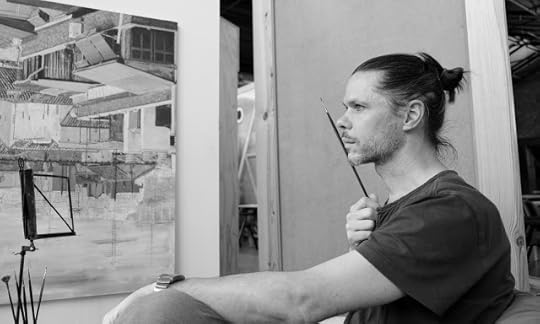 Centre for Artist Residencies, Matadero Madrid, Feb 2020. Photo by Lilián Pallares.
Centre for Artist Residencies, Matadero Madrid, Feb 2020. Photo by Lilián Pallares. Pintando sonidoTuve clases de piano desde los cinco años hasta los diez años, y luego tuve dos años de clarinete. Como mi madre era una cantante profesional, siempre teníamos un piano en casa, y aunque no continuaba con las clases, todavía me encanta estudiar. Recuerdo que iba a una tienda de música en Farnham donde hice un curso de arte y encontrando partituras de Peter Dickinson, Alexandre Tansman y Jonathan Harvey, y la emoción de convertir las notas en la página en sonido.
Mis padres tenían colecciones de repertorio clásico y me atrajo especialmente Robert Schumann. Una pieza en particular la aprendí de memoria pero no recuerdo el nombre. Fui a la universidad y tomé la guitarra, ya que era más práctico que el piano para viajar, y pronto me enganché con el flamenco. Años más tarde el flamenco me trajo a España, y hace un par de años finalmente compré un piano digital Yamaha de segunda mano. Traté de recordar la pieza de Schumann, pero solo pude recordar la primera sección de arpegios. Lo toqué una y otra vez. Escuché piezas en Youtube pero no pude encontrarla. La partitura no se encontraba en casa de mis padres, tal vez porque se habían mudado de casa dos veces mientras tanto. Compartí el fragmento que recordaba en Instagram con músicos amigos, pero fue en vano. Luego, de la nada, toqué la pieza hasta el final. Solo sucedió una vez y no pude repetirlo de nuevo... Pero estaba en algún lugar dentro de mí, ahora lo sabía. Unas semanas después, volvió de nuevo y esta vez estaba listo para captarla y no dejarla ir. Todavía no sé el nombre pero me encanta tocarlo.
Otra de las piezas de Schumann que comencé a aprender al mismo tiempo fue Romance 28 No2. Solo aprendí la primera página y el pianista neozelandés Terrance Dennis, que nos estaba visitando, me dio algunos consejos sobre cómo abordarla. Después de muchos intentos de ir más allá de la segunda página, pensé que ya era hora. Realmente hice un esfuerzo y este año he estado trabajando en ello la mayoría de los días, y escuchando una y otra vez las diferentes interpretaciones en Youtube. Así que hice una grabación mía tocando Schumann's Romance 28 No2. Espero que lo disfruten.
He metido los gritos de los vencejos que sobrevuelan los tejados de Madrid en primavera y verano – los tejados de la pintura en la que estoy ocupado trabajando en residencia artística–. Al igual que la música inacabada, el paisaje urbano me ha acompañado durante muchos años, y al igual que con el Romance, planeo continuar hasta que llegue al final.
Me encanta cómo la música puede evocar emociones, colores y formas, y cómo la música escrita se encuentra en la página. El Romance parece complicado ya que está escrito en tres pentagramas, pero esta también fue su atracción: cómo desenredar estas notas escritas por Schumann. A diferencia de una novela donde las palabras se convierten en imágenes en su mente, las partituras, al menos para mí, solo dan una impresión muy aproximada y el proceso de uno de 'leer', comprender y encontrar su propia interpretación en el piano es como tomarse el tiempo para escuchar a los pensamientos del compositor y reflexionar profundamente sobre lo que te están diciendo.
Mi pintura siempre tiene una estrecha relación con mis intereses: el flamenco y los artistas españoles son inspiraciones particulares. En mis pinturas abstractas trabajo de manera intuitiva y muy a menudo encuentro conexiones estrechas entre las cosas que me rodean y la pieza terminada. Una serie de acuarelas, por ejemplo, la titulé 'After Mozart' (Después de Mozart). Recuerdo haberlos colocado en el piano y me dio cuenta de que evocaban una melancolía velada, la misma sensación que la pieza que había estado estudiando en ese momento. No intento pintar conscientemente una pieza musical; podría intentarlo, pero me gusta esta sensación de sorpresa y la revelación de una conexión a un nivel más profundo.
Volviendo a mi pintura actual, me pregunto si Romance de Schumann está influyendo de alguna manera en la pintura. O tal vez mi interpretación de Romance ha recogido los colores y las texturas de los tejados de mi vecindario...
January 25, 2020
'Playing in the sun' – a new studio
We have a number of proposals we will be working on during the residency, encompassing painting, photography, storytelling, poetry and audiovisual creations, with collaborations with arts institutions and children of different ages.
To start the ball rolling I am continuing work on a large cityscape I began some ten years ago as I get a feel for this huge space and the activities going on in it; the way the light changes during the day, the sound of the heating like a distant aeroplane at take-off, the buzz during the regular morning workshop with people with learning disabilities, the rain on the high roof.
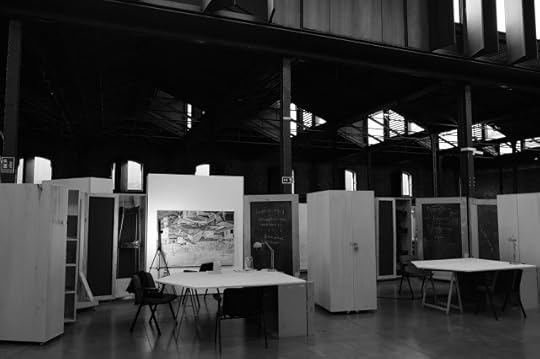
While working on this painting I'm reminded of the large landscape jigsaw puzzles my grandfather enjoyed doing, which he would stick on card to hang on the wall. I remember them hanging in his house in Nelson, New Zealand, a few pieces missing having come unstuck. I'm also reflecting how as children we keep going despite our mistakes. Imagine if we gave up trying to walk the first time we fell and scraped our knees, or gave up talking when someone corrected our language, we wouldn't get very far. But then as adults we sometimes become afraid of making a fool of ourselves. In my painting I become aware of my 'mistakes' but I keep going because it is part of the journey of discovery.
This takes me back to when I was around seven and didn't like going to school. I believed in my own abilities to learn from my own experiences and play. At the same time those around us can be an inspiration. My parents would read to my sister and me. We'd help in the garden or with the compost heap. My mother was studying singing and my father's ministry brought us into contact with many people from different backgrounds and we went on weekend visits to the marae out on the Otago peninsula. Just by following our own dreams and sharing that journey—the ups and the downs—we can allow those around us to also remember and return to their own dreams.
Talking of following ones dreams, Lilián is currently performing in the Cuban zarzuela Cecilia Valdés in the Teatro de la Zarzuela and will join me soon in the studio.
[1] The Matadero is a former slaughterhouse by the River Manzanares, now converted into a contemporary arts centre with theatre, exhibition spaces, activity spaces for children to promote reading and play, cinema, cafés, and a spacious plaza that sees outdoor concerts and fairs.
Pensamientos lentos
- Charles Olsen's profile
- 8 followers



